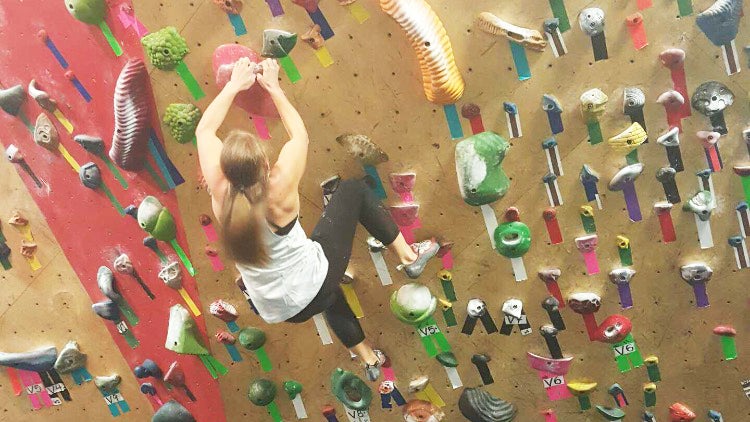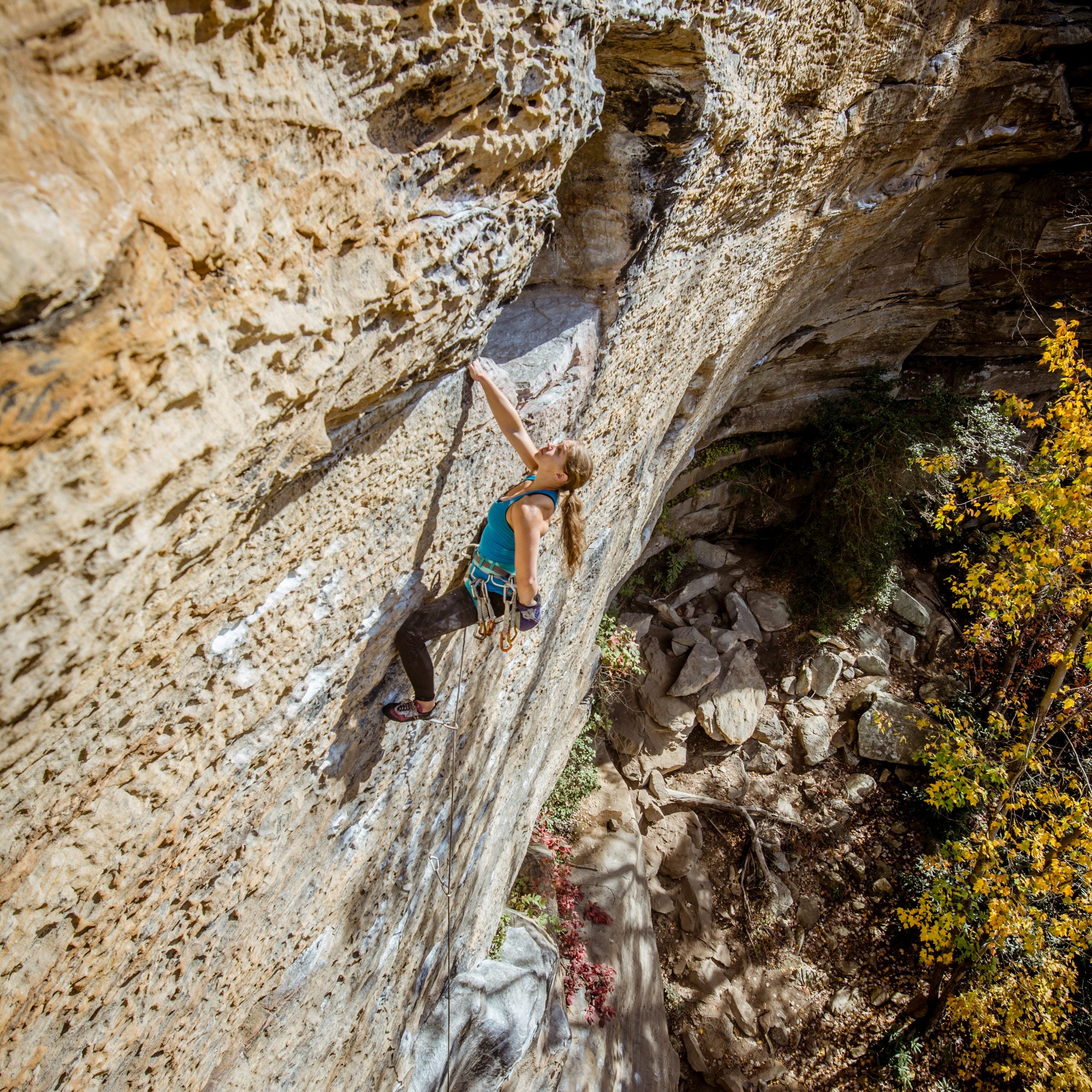discovered the climbing gym in college, like many who have fallen in love with the sport. But Laine, who at the time was a dance major considering medical school, took her passion for rock climbing to the extreme. As climbing became an increasingly important part of her life, Laine abandoned her premed track at Washington University in St. Louis, and eventually the idea of medical school entirely. Now she works full-time as a route setter at , one of New York City’s premier climbing and bouldering gyms.
Route setters are responsible for coming up with creative ways to place the holds in an indoor climbing gym. Laine, one of the few women with this job, has always been interested in putting up routes, especially flowy ones. She describes the work as a collision between an art form and a construction gig. “We talk a lot about aesthetics and making different feelings out of the rock climbs,” says Laine. “But we’re also using tools and going up and down ladders. It’s hard manual labor!”
Age: 25
Job: Route setter, Brooklyn Boulders
Hometown: Long Island, New York
Home Base: Brooklyn, New York
Morning Ritual: The NYC shuffle. “I wake up at 6 a.m. to move my car (to avoid parking tickets). And then I go for a run. The only reason I can run is that I have to move my car. And coffee.”
Hours: 9 a.m. to 5 p.m.
Climbing Hero: . “She’s just a really strong rock climber. After she [Ed note: becoming the first person to do so], she has the famous quote that I love: ‘It goes, boys!’ That’s what I want to embody as a female route setter: someone who is breaking barriers and showing other women that women can do what men can do.”
Favorite Piece of Gear: “My bouldering chalk bag. It has a lot of sentimental value.”
Favorite Place to Climb: The “because of its long sport routes.”
Bucket List Climbing Destination: . “I’m going this July.”

Getting into Route Setting: “I first set a few boulder problems for in Long Island. I would go in the summer between semesters and ask the head route setter every once in awhile if I could set. They’d let me set a problem during the day when no one was there. And they weren’t paying me—I was just doing it for fun. I started working for BKB in July 2013 as belay staff, and then at the front desk, and then doing coaching and teaching. In September 2016, I started route setting full-time. I’m on a team of about ten people working between the two BKB gyms.”
Prereqs for Setting: “You can just learn! USA Climbing has , but you don’t necessarily need one. I haven’t done any yet. Some of the guys I work with have Level One certifications, and there are five levels total. To set for the big comps in the U.S., you have to have a certain level of route setting. And if you were to apply for jobs, it’s a way to show that you actually know how to route set, because there’s such a variation of quality at different gyms—the certification offers a standard. It can vouch for how good you are.”
Typical Day at the Office: “I get to work at 9 a.m., most of the time by bike. We start our day by caution-taping off the area we’re gonna set. We strip the walls of holds from the previous routes, and clean the chalk and rubber off the walls. Then we set. There will be a chief or head route setter, who will make a spread for the day and tell us if we’re setting boulder problems and tell us the . On ropes, we’ll be on our own individual rope, and we’ll set two to three routes, hitting three different grades: easy, medium, and hard. Once we’re finished setting for the day, we forerun, which is where we climb everything we set and make sure it’s doable and that all the climbs are consistent and up to par. We might find that one move is way too hard or easy for a climb, so we make tweaks.”
How She Approaches Routes: “We have a lot of creative freedom. Pretty much the only thing we’re given in terms of guidance is grades, and even that’s up to us for the most part. If I’m gonna set a V3, I get to figure out what style I want to go for, and then determine what holds work for that, etc. I tend to set climbs that have a little bit of flow to them—I love when I get on a climb and each move feels natural and I can move constantly through holds rather than having to start and stop to figure out what to do next. On climbs that flow well, climbing feels intuitive. When I first started, I was making things too straightforward, so I’m trying to learn to make things a little less obvious and make sequences trickier.”
What People Don’t Understand About Setting: “I think a lot of people think that the process of route setting is a lot more structured than it is and that grading is a lot more structured than it is. I’ve realized that the grades we give to climbs are so arbitrary and subjective to how we’re feeling that day and to peoples’ different strengths and weaknesses. We’ll have discussions where someone will think a climb is super easy and someone else will think it’s hard, and we’ll have to figure out where it falls on the spectrum. It’s hard to do that in a completely unbiased way. When climbers who are (usually) new come to a gym and do what’s referred to as ‘grade chasing’ (climbing harder and harder routes), they get bummed when they can’t climb a V2 but just climbed a bunch of V3s. The grade says more about the route than you as a climber. Route setting is more about the movement and less about grade.”
The Difficulties (and Gender Dynamics) of Determining Difficulty: “One of the hard parts about being a is giving and receiving feedback. This happens when we forerun; it can be a sensitive subject. I have to remind myself that I’ve been climbing for a long time, so I should speak up if something feels off, but it’s been a process. And for [male setters] to take feedback from me has also been a learning process. I’m a lot weaker than the other members of my team, which isn’t true of all females, but it’s true of me. They all easily climb the hard grades, and sometimes I can’t do a lot of the hard climbs in a set.
“Once, there was a climb they all said was a V6, and I couldn’t even do the first move. I know that I should at least be able to do the first move, or the first few moves of a V6, but this one felt really difficult. It was fairly early on in my route setting, and I said that it seemed way too hard for V6, but a bunch of the other guys were convinced it was V6. I had this long discussion with them. The setter rotated a foot and added a hold and still called it V6, and I still didn’t think it was. The next day, they upped the grade because people were struggling. The lesson there is to be confident enough to have a voice and consider your feedback as valuable as the rest of the guys’.”
Most Rewarding Part of the Job: “Constantly having a challenge and really learning something every day. When I was teaching and coaching climbing, I was feeling stagnant and wasn’t getting enough stimulation because I was doing the same thing every day. I wanted to do something that was really focused on logic and reasoning and problem solving, and that’s what route setting is giving me. You get to come up with your own puzzle. I’m responsible for my day and the outcomes. Plus, it’s fun to watch people do my climbs.”
Lessons from the Job: “Take each day as it comes. You have some days when it seems like nothing you do turns out the way you want it to, when all your climbs seem terrible or disappointing. And then the next day you set all gems. It’s hard to tell why those days happen, but the lesson has always been not to get discouraged. I’ve beaten myself up about climbs I don’t think are good, and the next day I get a clean state to try again. It’s a good way to think about living, to try not to live in the past and to do your best the next day.”
How She Recharges: “I recharge by climbing, so it can get difficult because so much of my job is climbing. I think most of the setters on my team would consider themselves introverts. A lot of my recharge time is alone time, either taking time to climb on my own or read, but also climbing with friends. Most of it is just climbing. The answer is climbing!”
Future Plans: “I’m in the trial phase trying to figure out if I can do this as a career. It’s definitely something people can do as a career. I could do it for a long time and work my way up, but route setting is difficult and creative. It’s similar to being in the art world—it’s a struggle. You have to be talented and motivated.”
Advice for Aspiring Setters: “Try to talk to the route setters at your gym, and don’t be discouraged if all the route setters you see are men. There are plenty of women out there doing the job. If you’re committed and excited, you’re more than capable.”


